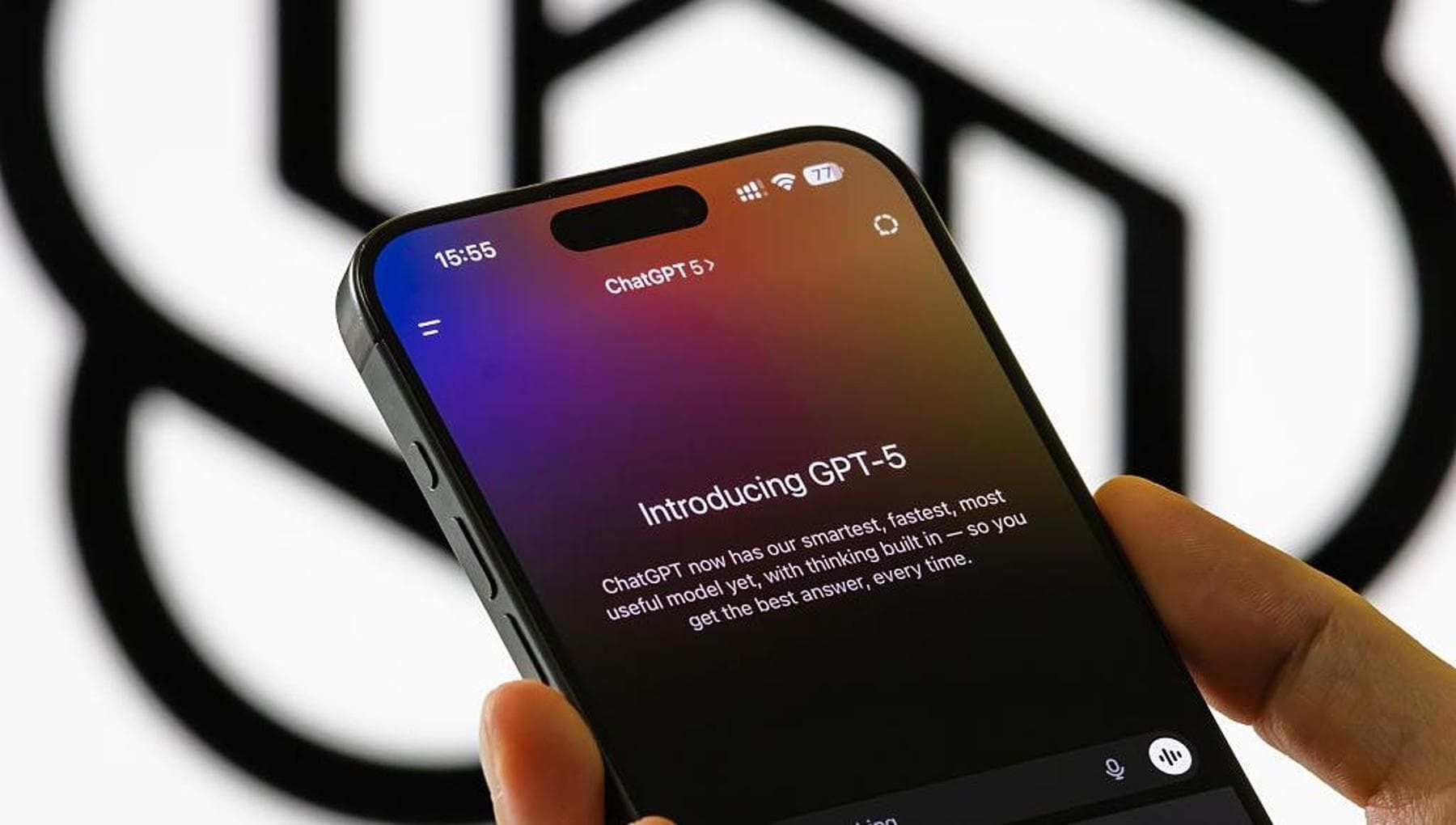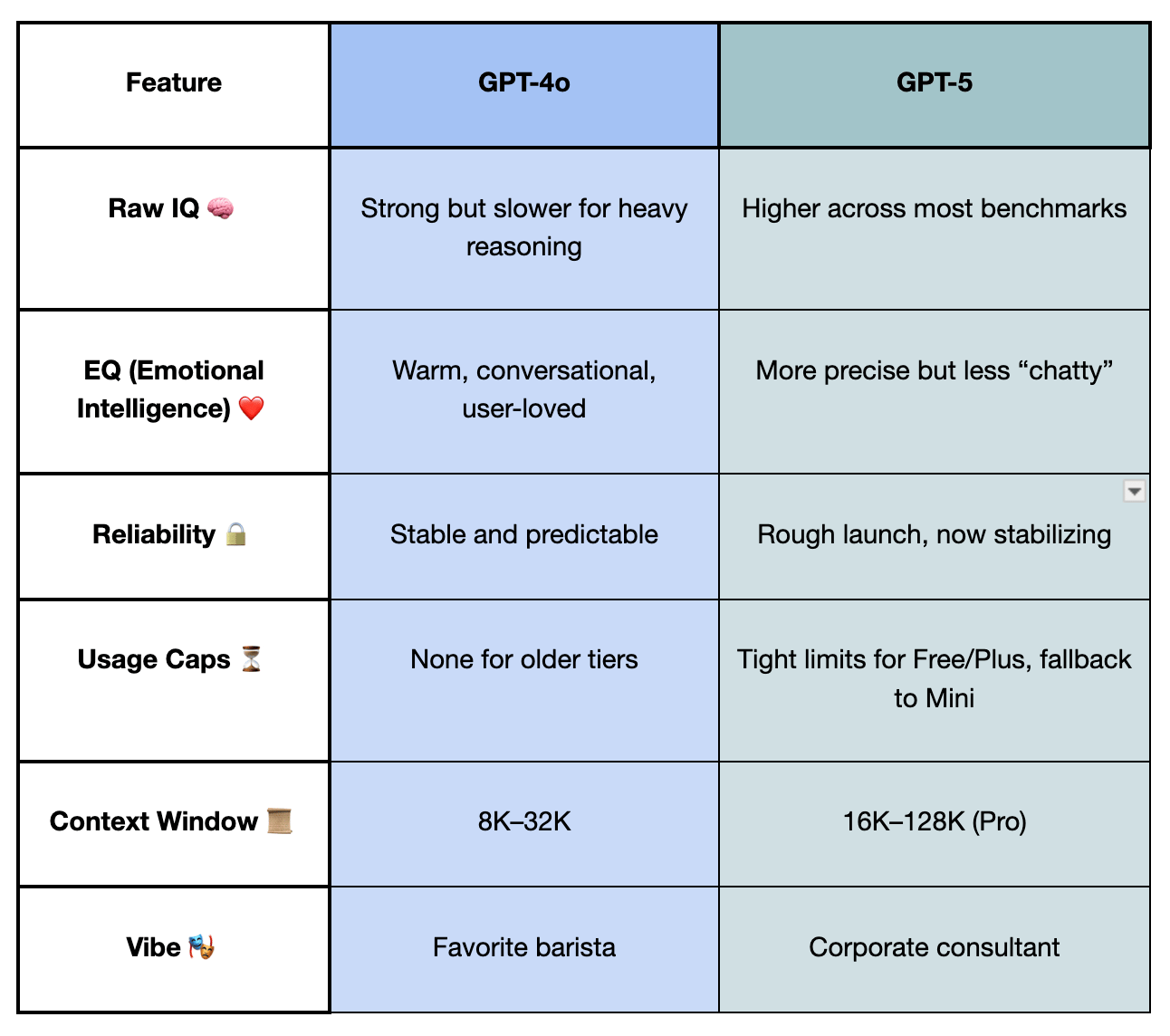Welcome back apprentices! 👋
You know that friend who shows up to brunch bragging about their “amazing new car,” only for you to notice the GPS thinks you live in the ocean and the stereo only plays polka?
That’s kind of what happened with OpenAI’s shiny new GPT-5.
It’s fast, powerful, and objectively impressive… but the rollout had just enough chaos to make you wonder if the check engine light is on.
In today's email
GPT-5 launched with speed and smarts, but a chaotic rollout.
Strict message caps push users to a weaker “Mini” model mid-task.
GPT-4o removal sparked backlash and partial return.
Launch missteps overshadowed the model’s technical gains.
+ New AI Tools
Read Time: 4 minutes
Quick News
📈 From AI Lab to Wall Street… With No Map. Leopold Aschenbrenner, a former OpenAI researcher fired in 2024 for allegedly leaking sensitive info, just raised over $1.5B for his “Situational Awareness” hedge fund — despite zero prior investing experience. Named after his viral AGI prediction essay, the fund is already up 47% in 2025, fueled by bets on semiconductors, infrastructure, and power companies tied to the AI boom. The success hints that in the AI gold rush, tech insiders might outpace Wall Street veterans when it comes to spotting the real winners.
🏠 Clippy’s Cool, AI-Powered Cousin Is Coming. Apple’s cooking up four AI-powered smart home gadgets for 2026–2027 — including a desktop robot with a motorized “face,” a personality-packed Siri called Bubbles (think Clippy but cuter), a new smart display, and battery-powered security cams that can set moods with lights and music. They’re also rebuilding Siri from scratch under the codename Linwood, while testing Anthropic’s Claude as a plan B. With Google, Amazon, and even OpenAI’s hardware projects racing ahead, Apple’s playing catch-up in a market still waiting for a breakout hit.
🤼♂️ Silicon Valley’s Pettiest Power Couple. Elon Musk says xAI is suing Apple for favoring OpenAI in the App Store and pushing out rivals like Grok. Sam Altman fired back with jokes about Musk’s “skill issue” and possible bots, while Grok itself jumped in to side with Altman. The spat spiraled into screenshots, trustworthiness polls, and accusations about algorithm tweaks — turning a legal gripe into something closer to a Twitter roast battle.
Together with Shutterstock
Training cutting edge AI? Unlock the data advantage today.
If you’re building or fine-tuning generative AI models, this guide is your shortcut to smarter AI model training. Learn how Shutterstock’s multimodal datasets—grounded in measurable user behavior—can help you reduce legal risk, boost creative diversity, and improve model reliability.
Inside, you’ll uncover why scraped data and aesthetic proxies often fall short—and how to use clustering methods and semantic evaluation to refine your dataset and your outputs. Designed for AI leaders, product teams, and ML engineers, this guide walks through how to identify refinement-worthy data, align with generative preferences, and validate progress with confidence.
Whether you're optimizing alignment, output quality, or time-to-value, this playbook gives you a data advantage. Download the guide and train your models with data built for performance.
OpenAI
GPT-5: The Upgrade That Tripped Over Its Own Shoelaces

GPT-5 was meant to be OpenAI’s sleek new sports car of AI — faster, smarter, and powerful enough to replace the messy garage of GPT-4o, 4.1, 4.5, and mini variants. Instead, the launch felt more like rolling out a Tesla with a faulty GPS and half the battery missing.
Yes, the benchmarks are jaw-dropping: faster reasoning, fewer hallucinations, deeper analysis on demand. But between the launch-day router crash, an infamous livestream “chart crime,” and the abrupt removal of GPT-4o (later partially reversed), OpenAI found itself in damage control mode.
The new “unified model” system is genuinely clever — automatically switching between quick-response and deep-thinking modes — but usage caps and a jarring “mini model” fallback have some users feeling like they’re being handed a Ferrari that sometimes turns into a go-kart mid-drive.
Key Points
The Real Model Lineup
Free tier → GPT-5 with 10 messages every 5 hours, 1 GPT-5 Thinking message/day. Falls back to GPT-5 Mini after cap.
Plus ($20/month) → 160 GPT-5 messages every 3 hours (temporary boost), up to 3,000 GPT-5 Thinking messages/week, Mini fallback after caps.
Pro / Team ($200+/month) → Unlimited GPT-5 and GPT-5 Thinking Pro with longer reasoning and bigger context (128K tokens). No fallback needed.
Mini → Automatically takes over after hitting caps; lighter, faster, but less capable.
“Unified Model” Brain → GPT-5 acts as a smart router:
Fast mode for everyday questions.
Thinking mode for complex, multi-step reasoning.
Chooses automatically based on your prompt complexity.
Apple integration → GPT-5 now lives inside Siri and Apple Intelligence (iOS 26/macOS 26), boosting writing tools, visual intelligence, and multi-turn conversation skills.
The glitch heard ‘round the web → Router failure on launch day sent tasks to the wrong models, making GPT-5 look dumber than it is.
Chart crime of the century → A botched slide in the livestream became a meme and shorthand for rushed product storytelling.
Fan-favorite revival → GPT-4o returned under “Legacy Models” for paid users after loud backlash over its removal.
GPT-5 vs. GPT-4o

Why This Might Be OpenAI’s Biggest Fumble Yet
The trouble with GPT-5’s debut isn’t that it’s a bad model — far from it — but that OpenAI managed to alienate a loyal user base in record time. By pulling GPT-4o, a model beloved for its warmth and personality, without warning, they created an instant trust gap. People don’t just use AI for its IQ; they form attachments to how it “feels,” and losing that overnight felt like having your favorite bartender replaced by a corporate trainee.
Then came the cap conundrum. For Plus users, GPT-5’s strict message limits mean that in the middle of a project, the system can suddenly downgrade to the lighter Mini model. The difference is obvious — it’s like swapping your top chef mid-dinner for the intern who just learned to boil pasta.
And of course, optics matter. Between the now-infamous “chart crime” livestream moment and stingy rate limits at launch, the public narrative slipped out of OpenAI’s hands, becoming more about blunders than breakthroughs. All of this unfolded while competitors like Anthropic and Google were circling, ready to pitch themselves as the “reliable alternative” — even if their tech isn’t quite as sharp.
So… What’s the Deal for You?
If you’re using GPT-5 daily — whether to code, write, or brainstorm — the biggest change is predictability.
The model’s “smart routing” and deeper reasoning are real strengths, but the caps mean you need to pace your work or pay up. If you’re a Plus user, be ready for sudden shifts in tone or depth when the Mini fallback kicks in.
Businesses relying on ChatGPT for customer-facing tasks need to plan for these quality swings — or stick to Pro/Team for consistency.
Think of GPT-5 like an espresso machine with three settings: quick shot, deep brew, and instant coffee. The quick shot is fine most days, but if you want the deep brew, budget your cups — and maybe don’t start a big project when you’re already on your last token of the hour.
Help Your Friends Level Up! 🔥
Hey, you didn’t get all this info for nothing — share it! If you know someone who’s diving into AI, help them stay in the loop with this week’s updates.
Sharing is a win-win! Send this to a friend who’s all about tech, and you’ll win a little surprise 👀
Today’s Toolbox
Burned Out From Content Creation?
Syllaby.io helps creators turn content ideas into faceless videos in minutes. No editing. No filming. Just results.
Build your brand and stay consistent—without burning out.
🧪 Test the Prompt
A playground for your imagination (and low-key prompt skills).
Each send, we give you a customizable DALL·E prompt inspired by a real-world use case — something that could help you in your business or job if you wanted to use it that way. But it’s also just a fun creative experiment.
You tweak it, run it, and send us your favorite. We pick one winner to feature in the next issue.
Bonus: you’re secretly getting better at prompt design. 🤫
👑 The winner is…
Last week, we challenged you to test GPT-4o’s visual generation skills with this prompt.
Here’s the WINNER:

Congrats to Logan for his creation!🥳
Want to be featured next? Keep those generations coming!
🎨 Prompt: Terminal of Untaken Journeys
Create a photorealistic image of an enormous, abandoned transportation terminal built for journeys never taken. The departure boards display surreal destinations like [emotion-based location name], while rows of dust-covered luggage remain unclaimed. In the center, a glowing gate shaped like [missed opportunity object] flickers silently. A faint breeze scatters old tickets across the marble floor. Light pours through the cracked ceiling, illuminating a single unopened letter lying by a bench.
Style: ultra-realistic cinematic photography, long shadows, moody natural light, fine detail with subtle movement.
We’ll be featuring the best generations in our next edition!
FEEDBACK
How was today's everydAI?
DISCLAIMER: None of this is financial advice. This newsletter is strictly educational and is not investment advice or a solicitation to buy or sell any assets or to make any financial decisions. Please be careful and do your own research.



